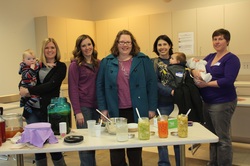
Basking Babies Buffet! February 2015
The weather turned snowy and yet 7 of us braved the weather to hear from Jamie Harter on the topic: “Fermenting Foods 101.” It was excellent! We learned the health benefits of probiotics through nutritious fermented foods. And Jamie shared some great samples and moms learned how to make sauerkraut, kombucha, ginger carrots and dairy kefir. "Fermented food is loaded with probiotics which is good for mom’s and baby's digestive tract.” SCROLL TO THE BOTTOM FOR PICS OF THE EVENT!
Jamie shared the following information with permission to post on the website:
My favorite websites for help and video instruction are thehealthyhomeeconomist.com
Culturesforhealth.com
Info on kefir
http://www.culturesforhealth.com/kefir#troubleshooting
Info on kombucha
Free ebook
http://www.culturesforhealth.com/free-kombucha-ebook
SAUERKRAUT-Makes 1 quart
1 medium cabbage, cored and shredded
1 tablespoon caraway seeds
1 scant tablespoon sea salt
In a bowl, mix cabbage with caraway seeds and sea salt. Let set in bowl at room temp for an hour. Place in a quart-sized, wide-mouth mason jar and press down firmly. Cover with cold, filtered water, being sure to keep the cabbage submerged under the brine. The top of the cabbage and brine should be at least 1 inch below the top of the jar. Cover tightly and keep at room temperature for about 3 days before transferring to cold storage. The sauerkraut may be eaten immediately, but it improves with age.
PINEAPPLE CHUTNEY-Makes 1 quart
1 small pineapple
1 bunch cilantro, coarsely chopped
1 tablespoon freshly grated ginger
2 tablespoons fresh lime juice
1 teaspoon sea salt
1/4 cup whey (page 87 in Nourishing Traditions)
1/2 cup filtered water
Mix pineapple, cilantro and ginger and place in a quart-sized, wide-mouth mason jar. Press down lightly with a wooden pounder or a meat hammer. Mix lime juice, sea salt and whey with water and pour over pineapple, adding more water if necessary to cover the pineapple. The chutney should be at least 1 inch below the top of the jar. Cover tightly and keep at roomtemperature for 2 days before transferring to refrigerator. This should be eaten within 2 months.
Variation: Hot Pineapple Chutney
Add 1 small red onion, 1 jalapeno pepper and 1/2 red pepper, all finely chopped.
GINGER CARROTS-Makes 1 quart
4 cups grated carrots, tightly packed
1 tablespoon freshly grated ginger
1 scant tablespoon sea salt
**These are the best introduction to lacto-fermented vegetables we know; the taste is delicious; and the sweetness of the carrots neutralizes the acidity that some people find disagreeable when they are first introduced to lacto-fermented vegetables. Ginger carrots go well with rich foods and spicy meats.
In a bowl, mix all ingredients together. Place in a quart-sized, wide-mouth mason jar and press down firmly with a pounder or meat hammer until juices cover the carrots. The top of the carrots should be at least 1 inch below the top of the jar. Cover tightly and leave at room temperature about 3 days before transferring to cold storage.
The weather turned snowy and yet 7 of us braved the weather to hear from Jamie Harter on the topic: “Fermenting Foods 101.” It was excellent! We learned the health benefits of probiotics through nutritious fermented foods. And Jamie shared some great samples and moms learned how to make sauerkraut, kombucha, ginger carrots and dairy kefir. "Fermented food is loaded with probiotics which is good for mom’s and baby's digestive tract.” SCROLL TO THE BOTTOM FOR PICS OF THE EVENT!
Jamie shared the following information with permission to post on the website:
My favorite websites for help and video instruction are thehealthyhomeeconomist.com
Culturesforhealth.com
Info on kefir
http://www.culturesforhealth.com/kefir#troubleshooting
Info on kombucha
Free ebook
http://www.culturesforhealth.com/free-kombucha-ebook
SAUERKRAUT-Makes 1 quart
1 medium cabbage, cored and shredded
1 tablespoon caraway seeds
1 scant tablespoon sea salt
In a bowl, mix cabbage with caraway seeds and sea salt. Let set in bowl at room temp for an hour. Place in a quart-sized, wide-mouth mason jar and press down firmly. Cover with cold, filtered water, being sure to keep the cabbage submerged under the brine. The top of the cabbage and brine should be at least 1 inch below the top of the jar. Cover tightly and keep at room temperature for about 3 days before transferring to cold storage. The sauerkraut may be eaten immediately, but it improves with age.
PINEAPPLE CHUTNEY-Makes 1 quart
1 small pineapple
1 bunch cilantro, coarsely chopped
1 tablespoon freshly grated ginger
2 tablespoons fresh lime juice
1 teaspoon sea salt
1/4 cup whey (page 87 in Nourishing Traditions)
1/2 cup filtered water
Mix pineapple, cilantro and ginger and place in a quart-sized, wide-mouth mason jar. Press down lightly with a wooden pounder or a meat hammer. Mix lime juice, sea salt and whey with water and pour over pineapple, adding more water if necessary to cover the pineapple. The chutney should be at least 1 inch below the top of the jar. Cover tightly and keep at roomtemperature for 2 days before transferring to refrigerator. This should be eaten within 2 months.
Variation: Hot Pineapple Chutney
Add 1 small red onion, 1 jalapeno pepper and 1/2 red pepper, all finely chopped.
GINGER CARROTS-Makes 1 quart
4 cups grated carrots, tightly packed
1 tablespoon freshly grated ginger
1 scant tablespoon sea salt
**These are the best introduction to lacto-fermented vegetables we know; the taste is delicious; and the sweetness of the carrots neutralizes the acidity that some people find disagreeable when they are first introduced to lacto-fermented vegetables. Ginger carrots go well with rich foods and spicy meats.
In a bowl, mix all ingredients together. Place in a quart-sized, wide-mouth mason jar and press down firmly with a pounder or meat hammer until juices cover the carrots. The top of the carrots should be at least 1 inch below the top of the jar. Cover tightly and leave at room temperature about 3 days before transferring to cold storage.
